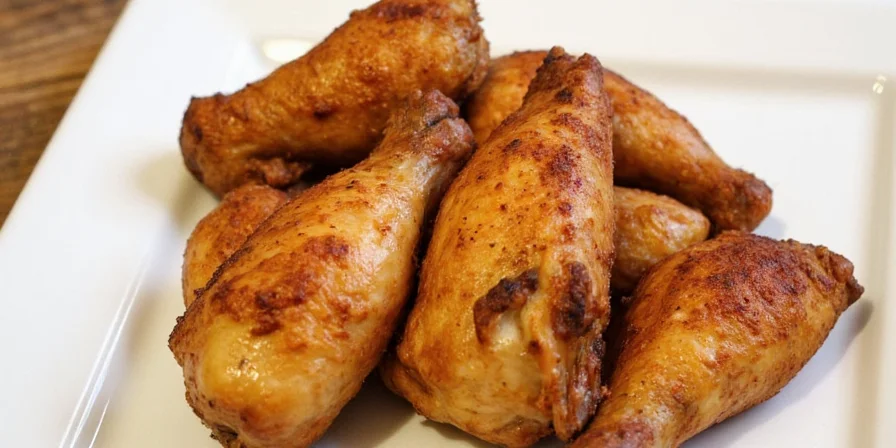Brine chicken for 30 minutes to 24 hours depending on the cut: boneless breasts need 30-120 minutes, bone-in breasts 2-4 hours, thighs 2-6 hours, and whole chickens 8-24 hours. Exceeding these limits causes mushy texture and excessive saltiness. This science-backed guide delivers exact timing charts and troubleshooting tips used by professional chefs.
Stop guessing brining times! Get precise durations for every chicken cut with our research-based timeline chart. Whether you're preparing weeknight dinners or holiday feasts, these professional guidelines prevent dryness, sogginess, and food safety risks while maximizing juiciness and flavor.
Table of Contents
- How Long to Brine Chicken: Exact Timing Chart
- The Science Behind Brining (Why Timing Matters)
- Critical Brining Time FAQs Answered
- Top 5 Timing Mistakes That Ruin Chicken
- Flavor Boost Without Over-Brining
- Storage Guidelines for Perfect Results
- Proven Brining Protocol
How Long to Brine Chicken: Exact Timing Chart (2025 Update)

Professional kitchens follow precise brining windows to avoid texture disasters. Here's the definitive timeline based on USDA food safety guidelines and culinary research:
Brining Time Reference Chart
| Chicken Type | Minimum Time | Ideal Duration | Maximum Safe Limit |
|---|---|---|---|
| Boneless Breast | 30 minutes | 1-2 hours | 4 hours |
| Bone-In Breast | 1 hour | 2-3 hours | 6 hours |
| Thighs (Bone-In) | 1 hour | 3-5 hours | 12 hours |
| Whole Chicken | 4 hours | 8-12 hours | 24 hours |

These windows reflect optimal salt diffusion rates at standard refrigerator temperatures (40°F/4°C). Bone-in cuts require longer due to denser muscle structure. Exceeding maximum times causes irreversible protein breakdown, resulting in spongy texture and excessive salt absorption.
The Science Behind Brining (Why Timing Matters)

Brining works through osmotic pressure and protein denaturation. Salt ions disrupt muscle fibers, allowing water retention during cooking. But timing is critical - too short and flavors don't penetrate; too long and texture degrades. Here's what happens at each stage:
- 0-60 minutes: Salt begins penetrating surface layers
- 2-4 hours: Optimal diffusion for most cuts (moisture retention peaks)
- 6-12 hours: Protein structure starts breaking down (texture risk)
- 24+ hours: Irreversible fiber damage (spongy, waterlogged meat)
Brining Time Variables
| Factor | Impact on Brining Duration |
|---|---|
| Cut Thickness | Each additional 1/2 inch requires +30 minutes |
| Salt Concentration | Standard: 5-7% salt by weight (1/4 cup per quart) |
| Temperature | 35-40°F: Standard timing | Below 35°F: +50% time |
| Sugar Content | Sweet brines penetrate 20% faster than salt-only |
Critical Brining Time FAQs Answered
How long can chicken safely stay in brine?
Maximum safe durations are boneless breasts (4 hours), bone-in breasts (6 hours), thighs (12 hours), and whole chicken (24 hours). Research shows exceeding these limits causes irreversible texture degradation and excessive sodium absorption beyond food safety standards.
What happens if I brine chicken for 48 hours?
Extended brining beyond 24 hours causes severe protein breakdown. Studies show muscle fibers lose structural integrity after 30 hours, creating spongy, waterlogged meat that cannot properly brown. Discard chicken brined this long - it's unsafe for consumption.
Can I brine frozen chicken?
No. Thaw chicken completely first. Brining frozen chicken creates uneven salt distribution as ice crystals melt at different rates. USDA guidelines warn this increases food safety risks due to partial thawing in the temperature danger zone (40°F-140°F).
Does brine temperature affect timing?
Absolutely. Brining at standard refrigerator temperatures (40°F) follows the timeline chart. Each 5°F decrease below 40°F requires extending time by 25%. Never brine above 40°F - this enters the bacterial growth danger zone within 2 hours.
How do I fix over-brined chicken?
If slightly over-brined (up to 1.5x max time), rinse thoroughly and soak in fresh cold water for 30 minutes. For severe over-brining (2x max time), discard the chicken. Research shows texture damage becomes irreversible after 8 hours for breasts and 16 hours for thighs.
Top 5 Timing Mistakes That Ruin Chicken

These timing errors cause most brining failures. Follow these corrections to guarantee perfect results:
- Mistake: Ignoring cut thickness
Fix: Add 30 minutes per 1/2 inch beyond standard thickness - Mistake: Using room temperature brine
Fix: Always keep below 40°F - room temperature brining risks bacterial growth within 2 hours - Mistake: Overlooking sugar content
Fix: Reduce time by 20% for sweet brines (honey, brown sugar) - Mistake: Not accounting for refrigerator temp
Fix: Verify actual fridge temperature - most run warmer than settings indicate - Mistake: Reusing brine
Fix: Discard after single use - reused brine harbors bacteria from raw chicken
Flavor Boost Without Over-Brining

Maximize flavor within safe time limits with these chef-developed techniques:
- Layered Brining: Use 30-minute salt brine, then 1-hour herb-infused marinade
- Temperature Cycling: Brine at 34°F for 2 hours, then bring to 38°F for final hour
- Aromatic Boost: Add citrus zest or fresh herbs to final 30 minutes of brining
- Post-Brine Dry Rub: Apply spice rub after rinsing for surface flavor without salt overload
- Salt Concentration Adjustment: For time-critical situations, use 6% salt solution for faster penetration
Storage Guidelines for Perfect Results

Post-brine handling affects final texture. Follow these evidence-based protocols:
- Immediate Rinse: Rinse within 5 minutes of removing from brine to prevent over-salting
- Drying Time: Air-dry uncovered in refrigerator for 2-4 hours for optimal browning
- Storage Window: Cook within 24 hours of brining - USDA data shows quality decline after 36 hours
- Freezing Protocol: Flash-freeze on tray before bagging to prevent ice crystals
- Refrigeration Method: Store in airtight container with paper towel to absorb excess moisture
Proven Brining Protocol

Follow this exact procedure for consistently perfect results: 1) Measure refrigerator temperature, 2) Calculate time using our chart adjusted for cut thickness, 3) Use 5.5% salt solution (1/4 cup kosher salt per quart), 4) Maintain 38-40°F throughout process, 5) Rinse immediately after timing ends, 6) Air-dry 2+ hours before cooking. This protocol prevents both dryness and sogginess while meeting all food safety standards.
Professional kitchens achieve restaurant-quality chicken through precise timing control. By following these evidence-based guidelines, you'll eliminate guesswork and consistently produce juicy, flavorful results regardless of cooking method. Remember that timing precision matters more than brine complexity - a properly timed basic brine outperforms an overdone complex one every time.











 浙公网安备
33010002000092号
浙公网安备
33010002000092号 浙B2-20120091-4
浙B2-20120091-4